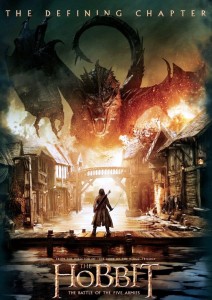 I’ve written tens of thousands of words on the Hobbit trilogy. It truly appears that there is nothing left for me to say about it. But it’s not over. Not yet.
I’ve written tens of thousands of words on the Hobbit trilogy. It truly appears that there is nothing left for me to say about it. But it’s not over. Not yet.
As all True Hobbit Fans™ know, the movies aren’t official over until the extended edition comes out and we are nearing the release date of Peter Jackson’s last Middle Earth extended edition. (The digital edition arrive October 20 while the Blu Ray arrives November 17).
What does this mean?
I don’t know. A lot of the narrative weight of the trilogy rests on the last film. The first two films in the series raised a ton of questions about the questionable nature of Thorin’s quest, the significance of the Arkenstone, possible necromancy in Dol Guldur, and Smaug’s political alliance with Sauron. Many of those questions got left behind as the tension between the different armies kicked into high gear. Characters were slain, including dwarves we had known for three movies, but their deaths didn’t quite resonate with the emotional impact many were expecting. It ended almost too soon.
The theatrical version did give us one final spectacular battle but curiously removed the main heroes from the heat of battle and had them split up to get killed off one by one.
The Dol Guldur subplot that has been years in the making resulted a cameo-filled battle that was both visually stunning battle and painfully short.
Even the signature Peter Jackson length was trimmed down to neat 2 hours and 24 minutes, instead of his trademark 3 hours.
The biggest issue however is that the third film was juggling way too many balls. It didn’t quite figure out how to integrate Tauriel, Legolas, Radagast, and Alfrid into the story naturally. It didn’t solve the mystery of the dwarven rings of power. It didn’t explain Thorin’s dragon sickness or even give him a heroic death. And it didn’t quite set up a satisfying link to the next trilogy.
I’m not saying the trilogy is a failure. I wouldn’t have spent literally days of my life watching, rewatching, and analyzing the films if I didn’t have an inordinate love toward them. But I have to wonder if there’s any way the extended edition could rehabilitate the parts of the installment that didn’t work out. Could the extended edition redeem the film? Will it sufficiently answer all our questions?
Probably not. What’s done is done. An extended edition will most likely be just a longer version of what we already have, not an actual reworking of material. We’ll get a little more here and there, an extra action set piece involving the dwarves, and hopefully a little more resolution for Thorin’s death in the form of an actual funeral, but it is what it is.
The Hobbit is an ambitious trilogy that had a lot of potential and actually turned out pretty great considering the conditions under which it was made (a stalled production that was suddenly rushed into existence with a reluctant substitute director with only three months to prepare), but those limitations really show up most in this third film. Although it’s a minor miracle that it got made at all, that doesn’t make the loose ends easier to swallow.
Even though the creative decision to split the films into a trilogy at the last minute didn’t result with a powerful conclusion to the story, it did give us more time with a stellar cast of memorable characters in a stunning fantasy world, three beautifully haunting scores, and 27 hours of behind-the-scenes features that are a masterclass in blockbuster filmmaking all by themselves.
I eagerly await the final extended edition and will be watching as soon as it hits digital shelves. The Hobbit Trilogy for all its flaws is still leaps and bound above most fantasy films and an enthralling ride back to Middle Earth. Even if the plot is shaky from time to time, the characters and the world they inhabit will continue to hold up for years to come. What will our final 20 minutes with The Hobbit be like? I can’t wait.
